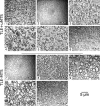In vivo diffusion tensor imaging and histopathology of the fimbria-fornix in temporal lobe epilepsy
- PMID: 20089908
- PMCID: PMC6633109
- DOI: 10.1523/JNEUROSCI.1619-09.2010
In vivo diffusion tensor imaging and histopathology of the fimbria-fornix in temporal lobe epilepsy
Abstract
While diffusion tensor imaging (DTI) has been extensively used to infer micro-structural characteristics of cerebral white matter in human conditions, correlations between human in vivo DTI and histology have not been performed. Temporal lobe epilepsy (TLE) patients with mesial temporal sclerosis (MTS) have abnormal DTI parameters of the fimbria-fornix (relative to TLE patients without MTS) which are presumed to represent differences in axonal/myelin integrity. Medically intractable TLE patients who undergo temporal lobe resection including the fimbria-fornix provide a unique opportunity to study the anatomical correlates of water diffusion abnormalities in freshly excised tissue. Eleven patients with medically intractable TLE were recruited (six with and five without MTS) for presurgical DTI followed by surgical excision of a small specimen of the fimbria-fornix which was processed for electron microscopy. Blinded quantitative analysis of the microphotographs included axonal diameter, density and area, cumulative axon membrane circumference, and myelin thickness and area. As predicted by DTI the fimbria-fornix of TLE patients with MTS had increased extra-axonal fraction, and reduced cumulative axonal membrane circumference and myelin area. Consistent with the animal literature, water diffusion anisotropy over the crus of the fimbria-fornix was strongly correlated with axonal membranes (cumulative membrane circumference) within the surgical specimen (approximately 15% of what was analyzed with DTI). The demonstration of a correlation between histology and human in vivo DTI, in combination with the observation that in vivo DTI accurately predicted white matter abnormalities in a human disease condition, provides strong validation of the application of DTI as a noninvasive marker of white matter pathology.
Figures





Similar articles
-
White-matter diffusion abnormalities in temporal-lobe epilepsy with and without mesial temporal sclerosis.J Neurol Neurosurg Psychiatry. 2009 Mar;80(3):312-9. doi: 10.1136/jnnp.2007.139287. Epub 2008 Oct 31. J Neurol Neurosurg Psychiatry. 2009. PMID: 18977826
-
Thalamic diffusion and volumetry in temporal lobe epilepsy with and without mesial temporal sclerosis.Epilepsy Res. 2008 Aug;80(2-3):184-93. doi: 10.1016/j.eplepsyres.2008.04.002. Epub 2008 May 19. Epilepsy Res. 2008. PMID: 18490143
-
Hemispheric Regional Based Analysis of Diffusion Tensor Imaging and Diffusion Tensor Tractography in Patients with Temporal Lobe Epilepsy and Correlation with Patient outcomes.Sci Rep. 2019 Jan 18;9(1):215. doi: 10.1038/s41598-018-36818-x. Sci Rep. 2019. PMID: 30659215 Free PMC article.
-
Diffusion tensor imaging in temporal lobe epilepsy.Epilepsia. 2011 Jul;52 Suppl 4:32-4. doi: 10.1111/j.1528-1167.2011.03149.x. Epilepsia. 2011. PMID: 21732939 Review.
-
White matter in temporal lobe epilepsy: clinico-pathological correlates of water diffusion abnormalities.Quant Imaging Med Surg. 2015 Apr;5(2):264-78. doi: 10.3978/j.issn.2223-4292.2015.02.06. Quant Imaging Med Surg. 2015. PMID: 25853084 Free PMC article. Review.
Cited by
-
Muscular weakness in individuals with HIV associated with a disorganization of the cortico-spinal tract: a multi-modal MRI investigation.PLoS One. 2013 Jul 11;8(7):e66810. doi: 10.1371/journal.pone.0066810. Print 2013. PLoS One. 2013. PMID: 23874398 Free PMC article.
-
MR-Guided Focused Ultrasound for Refractory Epilepsy: Where Are We Now?J Clin Med. 2023 Nov 13;12(22):7070. doi: 10.3390/jcm12227070. J Clin Med. 2023. PMID: 38002683 Free PMC article.
-
Macroscale and microcircuit dissociation of focal and generalized human epilepsies.Commun Biol. 2020 May 18;3(1):244. doi: 10.1038/s42003-020-0958-5. Commun Biol. 2020. PMID: 32424317 Free PMC article.
-
Different patterns of fornix damage in idiopathic normal pressure hydrocephalus and Alzheimer disease.AJNR Am J Neuroradiol. 2012 Feb;33(2):274-9. doi: 10.3174/ajnr.A2780. Epub 2011 Nov 11. AJNR Am J Neuroradiol. 2012. PMID: 22081679 Free PMC article.
-
Utility of diffusion tensor imaging parameters for diagnosis of hemimegalencephaly.Neuroradiol J. 2015 Dec;28(6):628-33. doi: 10.1177/1971400915609334. Epub 2015 Oct 19. Neuroradiol J. 2015. PMID: 26481187 Free PMC article.
References
-
- Arfanakis K, Hermann BP, Rogers BP, Carew JD, Seidenberg M, Meyerand ME. Diffusion tensor MRI in temporal lobe epilepsy. Magn Reson Imaging. 2002;20:511–519. - PubMed
-
- Beaulieu C. The basis of anisotropic water diffusion in the nervous system-a technical review. NMR Biomed. 2002;15:435–455. - PubMed
-
- Beaulieu C, Allen PS. Determinants of anisotropic water diffusion in nerves. Magn Reson Med. 1994a;31:394–400. - PubMed
-
- Beaulieu C, Allen PS. Water diffusion in the giant axon of the squid: implications for diffusion-weighted MRI of the nervous system. Magn Reson Med. 1994b;32:579–583. - PubMed
Publication types
MeSH terms
Grants and funding
LinkOut - more resources
Full Text Sources
Research Materials
